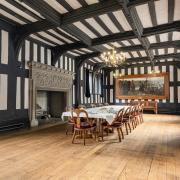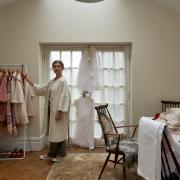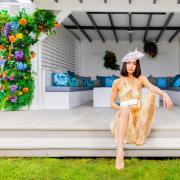The Hall at Lyme Park is the largest in Cheshire and was constructed over several centuries. The estate was granted to the heirs of Sir Thomas Danyers in 1398 by Richard II, son of the Black Prince. It passed to the Legh family by marriage, when Sir Thomas’s only heir, his granddaughter Margaret, married Piers Legh and it remained within the family until 1946, when Richard Legh, 3rd Baron Newton, gave it to the National Trust.
There are records of a house first being built on this site in 1465, but this was demolished when construction of the present hall began, in the middle of the 16th century. This house was very much of its time, in an L-shape, with east and north wings; piecemeal additions were made to it during the 17th century and in the 1720s Venetian architect Giacomo Leoni, added a south range to the house creating a courtyard plan. Today, you enter the house through the north side, turning to the east to view the glorious, designed-to-impress, entrance hall.

Responsibility for Lyme Hall today lies with collections and house manager Kat Croxford, together with senior collections and house officer Nicola Whyton and four collections assistants.
‘We have around 100,000 visitors who come through the house each year,’ Kat says. ‘We’re open six days a week. A major part of the house people see today is as it was in the 19th century, around Thomas Legh’s time.’
Thomas Legh was quite the adventurer. He was the oldest illegitimate son of Thomas Peter Legh, who died unmarried aged 43, leaving seven offspring. After graduating from Oxford, Thomas followed the crowds of wealthy young bucks of the age, setting off on a Grand Tour. Thomas took his tour a little further than classical Greece, however, and he was the first Westerner to travel down the Nile, right as far as Nubia. Hanging by the hall’s grand staircase is a rather fabulous portrait of him, in exotic clothing of loose white trousers and red boots, with a turban around his head, a bowing Arab horse and a suitably awestruck Turk sitting at his feet.

‘Throughout the years many changes have taken place but as a collections team, with our curators and conservators, we decide what goes out on display. Much of Lyme’s collection is still owned by the Legh family, the current Lord Newton and his brother, and they allow us to display the pieces in their ancestral home. We also work with lots of partners, such as the Lady Lever Gallery, the Whitworth Gallery, the Manchester Museum and the National Portrait Gallery, to make sure the house looks its best.
‘When we need to redecorate, we research what the interior decoration looked like during the time we want to portray. We take paint scrapings, going back through the layers to find what colour was used in the 19th century, which was the last time major changes took place in the house.
‘In 2010, a number of items came back to us, into the National Trust’s possession, through a scheme called acceptance in lieu. This is a government project that allows families to offer items in lieu of paying death duties. The items that have come back to use belonged to the Legh family, which is known from historical inventories – we have a really clear one from 1879 and one from 1929 – so we can find the items there. 'There’s a leather screen up in the Long Gallery and a couple of beds that we will have on display this year. We’re actively seeking objects that were sold in a large-scale auction in 1946 before the property was gifted to the National Trust, and we have a few things in the pipeline we’re working on acquiring.’

As you walk into the entrance hall, the first items that attract attention are the huge tapestries draping each wall, though the row of grand fluted column traversing the width of the space seem somewhat out of place.
‘This room was designed to impress,’ Kate says. ‘It was last redecorated in 1904, by the Joubert Brothers. The décor in here is therefore later than the rest of the house and it’s one of the rooms we’re looking at redecorating. It would all have been grained in here, it would have been much darker, with a more sumptuous feel. (Graining being a paint scheme made to look like wood.)
‘The columns were put in when the hall was extended forward into the courtyard space, by Giacomo Leoni. The tapestries, from the Mortlake Tapestry Works, were made in 1625. There were six originally. Unfortunately, one was lost in a fire in Belgium, when the house was still owned by the family. Another is on loan to the Victoria and Albert Museum, and one is in storage.’
Another large tapestry from Lyme is currently going through conservation, and it’s been discovered that, despite believing the cloth had been cut to fit the space it occupied, in fact it had been carefully pleated, enabling the conservators to see the colours of the tapestry before it was folded.

From the entrance hall we progress to the grand stairs, which are truly grand. Richly polished wood glows against deep red walls set with vast paintings, many of them portraits of the Leghs over the centuries, but also hunting scenes, dogs, deer and the famous white cattle. It is here we find Thomas Legh in his eastern garb, and paintings of the treasured Lyme mastiffs, a breed that had its foundation in 1415. The story goes that in 1415 Sir Piers Legh was wounded in the Battle of Agincourt, and his mastiff stood over and protected throughout the remainder of the battle. The mastiff came home to Lyme with Sir Piers, and the Lyme mastiff strain started there. They were bred at the hall and kept separate from other strains, playing an important role in the founding of the modern breed. The Lyme strain died out around the beginning of the 20th century. The family clearly loved their mastiffs as they feature in many paintings, often with very small children dwarfed by the vast hound.


Like the grand stairs, the library is a warm, deep red, and the red and gold wallpaper is a clear example of how the National Trust works to create room schemes that track back to their original form. The wallpaper has been reproduced to precisely match that discovered when the room was being prepared for redecoration. There are also two replicas of marble stelae brought back to Lyme by Thomas Legh in the 19th century. We also see the first example of The Severed Arm, a motif that appears throughout the house.
The Severed Arm crest was gifted to Sir Thomas Danyers, along with an annuity, by the Black Prince, following the sack of Caen, in 1346. In 1398 the annuity was traded for the same value as the Black Prince’s lands in Cheshire, and the family proudly used the Severed Arm to make their connection to the throne very clear. Sir Thomas, having seen the prince’s standard taken by the French during the fighting, went after it, chopped off the arm of the French nobleman who had captured it, and brought it back to Prince Edward, son of King Edward III. To avert the humiliation of losing a standard was a great thing and Danyers richly deserved his prize. The motif of the Severed Arm can be seen throughout Lyme Hall, most easily when you look up at the ceiling roses, where it proudly clutches the cross of St George.

The long gallery is one of the original Elizabethan rooms at Lyme, untouched by later generations. As well as the Tudor panelling and ornately plastered ceiling, there is a fireplace with the arms of Elizabeth I set above. It’s hard to step into the space without imagining those cossetted ladies and gentlemen who would stroll its floors, taking their exercise indoors when the weather outside was inclement.
The drawing room is, perhaps unexpectedly, one of the most homely rooms in the hall. The extremely grand fireplace may have a fabulous carved stone overmantle, with the arms of Elizabeth I, but there is a sense of peace and pleasure here, helped, no doubt, by the knowledge that Thomas Legh bought the harp for his first wife, Ellen Turner, who died in childbirth before it arrived from France. It was then given to his second wife, Maud.


The bay windows feature medieval stained glass, which was originally in the church, in the adjacent village of Disley. Thomas Legh decided he wanted it in his house, so had it removed and brought to the hall. It’s not recorded how the parishioners felt about this, or what he did to replace it, but as the Leghs had built the church several centuries prior, Thomas is likely to simply have thought of it as his to take. As it lists the knights of the garter from the Elizabethan period, it was very much a statement of how impressive his family lineage was, and the use of the motto of the garter knights, Honi soit qui mal y pense, set set in gold leaf surrounding the arms of Elizabeth I on the fireplace supports this declaration.
‘The use of the church’s windows here is just another example of how everything Thomas did was to show off how ancient and prestigious his family was,’ Kat says. ‘He was very much Lyme’s Mr Darcy: he was very focused on his family’s position in society and he was extremely wealthy, with an income of £30,000 a year. But then he was also the magistrate who sat on the scandalous case of the alleged abduction and attempted forced marriage of heiress Ellen Turner, who he then went on to marry himself, when she was just 16. There’s a story we shall never know the truth of, but the house is full of those, perhaps.’
As family histories go, the Leghs of Lyme Park certainly have tales to tell.
The photography for this feature was kindly supplied by Christopher John, a professional photographer specialising in landscapes, architecture and interiors.
christopherjohnphotography.co.uk




























